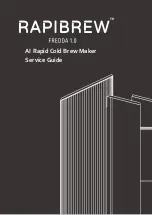
BLUEBOX Gen.2 HFM
Page 11 of 37
indicating that the message is not completed and another data packet will
follow.
The communication between ‘master’ and ‘slave’ for a command message take
place with the following handshake:
1.
The ‘master’ loads the buffer with the command message and
subsequently sets to ‘1’ the flag ‘Req tx’ to inform the ‘slave’ that a data
packet is ready to be acquired
2.
The ‘slave’ acquires the data packet from the ‘master’ and confirm the
completion of the operation by setting to ‘1’ the flag ‘Ack tx’
3.
After having received the acknowledgment of the completion of the
operation through the flag ‘Ack tx’ at ‘1’, the ‘master’ resets to ‘0’ the
flag ‘Req tx’
4.
After having verified that the flag ‘Req tx’ is reset to ‘0’, also the ‘slave’
resets to ‘0’ the flag ‘Ack tx’
5.
During the execution time of the received command, the ‘slave’ sets to
‘1’ the flag ‘Busy’ to inform the ‘master’ that it is not temporarily not
available for further communication
In the case of a message length that needs more than one data packet, the
previous handshake will be repeated for every data packet until the end of the
message.
The answer of the ‘slave’ to a command message from the ‘master’ can take
place through a full answer message or in a short form depending of the type
of command. In the case of a short form answer, it take place through the
setting to ‘1’ of the flag ‘Reply Ack’ or the flag ‘Reply Nak’ (in function of the
result of the execution of the command).
The communication between ‘slave’ and ‘master’ for an answer message take
place with the following handshake:
1.
The ‘slave’ loads the buffer with the answer message and subsequently
sets to ‘1’ the flag ‘Req rx’ to inform the ‘master’ that a data packet is
ready to be acquired
2.
The ‘master’ acquires the data packet from the ‘slave’ and confirm the
completion of the operation by setting to ‘1’ the flag ‘Ack rx’
3.
After having received the acknowlegment of the completion of the
operation through the flag ‘Ack rx’ at ‘1’, the ‘slave’ resets to ‘0’ the flag
‘Req rx’
4.
After having verified that the flag ‘Req rx’ is reset to ‘0’, also the ‘master’
resets to ‘0’ the flag ‘Ack rx’
In the case of a message length that needs more than one data packet, the
previous handshake will be repeated for every data packet until the end of the
message.
Practical example:
The ‘master’ device requests the inventory of the transponder/s present/s near
the antenna; for the example, we suppose that there are 2 ICODE2
transponders having the following hex codes: 0xE0, 0x04, 0x01, 0x00, 0x01,
0x02, 0x03, 0x04 and 0xE0, 0x04, 0x01, 0x10, 0x11, 0x12, 0x13, 0x14.
The bit 7 of the first byte of the header of the incoming buffer of the ‘master’
device will be indicate as ‘T’ (toggle) because we suppose that the ‘slave’ is
running correctly.












































